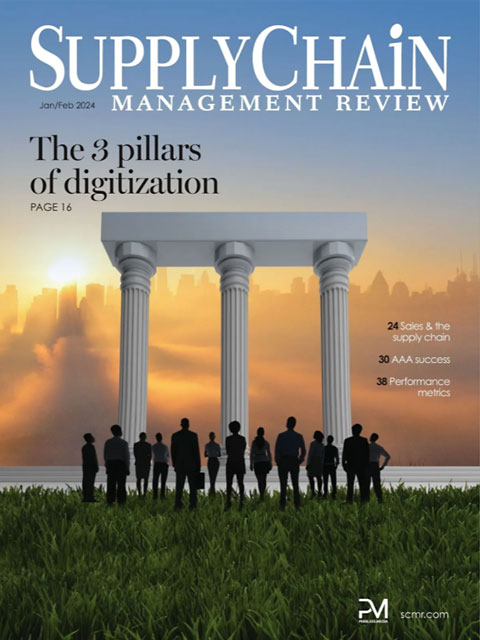Sorry, but your login has failed. Please recheck your login information and resubmit. If your subscription has expired, renew here.
January-February 2024
Back in 2019, we seemed on a consistent path to the future. Then COVID-19 arrived on the global scene, and all predictions went out the window. As 2024 begins, everyone wants to know what the year will look like. I predict continued interest in circular supply chains, cybersecurity, visibility, and digital supply chains, to name a few. But I am not alone. So, I’d like to share five things that I am particularly interested in this year. Browse this issue archive.Need Help? Contact customer service 847-559-7581 More options
Supply chains lack the required “high-fidelity” data and capabilities to operate in today’s complex business climate that is characterized by excessive supplier and logistics risks and disruptions, rapidly evolving sustainability and geopolitical requirements, growing implications of customer centricity, and hybrid channels to market. Successful organizations must pursue a different approach to innovate and re-invent their supply chains. Firms that cannot will fail as they are characterized by flatlined revenues, longer lead times, bloated inventory, and shrinking margins with surging SG&A (selling, general, and administrative) costs.
The role of supply chains has significantly evolved from the basic needs of satisfying customers (1990s), to servicing global markets (2000s), to driving profitability (2010s), to enabling customer centricity and differentiation while managing complexity in today’s markets. Managing complexity, whilst enabling resilience, is the operative phrase as supply chains today are a CEO and board-level mandate with a focus on reinvention, with more change in the last four years than in the previous 40 years. The success and evolution of all companies are underpinned by creating new high-fidelity supply chains with a forward-looking lens that incorporates three critical success factors (CSF) to future-proof organizations and enable resilience.
Based on extensive academic research and extensive industry experience, we apply these three factors discussed below, using a new approach to drive your next-gen supply chain transformation strategy. By understanding and incorporating these factors, supply chain transformation strategies can pivot from the traditional top-down, large-scale, process-driven reengineering approaches that lack agility and results.

This complete article is available to subscribers only.
Log in now for full access or start your PLUS+ subscription for instant access.
SC
MR
Sorry, but your login has failed. Please recheck your login information and resubmit. If your subscription has expired, renew here.
January-February 2024
Back in 2019, we seemed on a consistent path to the future. Then COVID-19 arrived on the global scene, and all predictions went out the window. As 2024 begins, everyone wants to know what the year will look like. I… Browse this issue archive. Access your online digital edition. Download a PDF file of the January-February 2024 issue.Supply chains lack the required “high-fidelity” data and capabilities to operate in today’s complex business climate that is characterized by excessive supplier and logistics risks and disruptions, rapidly evolving sustainability and geopolitical requirements, growing implications of customer centricity, and hybrid channels to market. Successful organizations must pursue a different approach to innovate and re-invent their supply chains. Firms that cannot will fail as they are characterized by flatlined revenues, longer lead times, bloated inventory, and shrinking margins with surging SG&A (selling, general, and administrative) costs.
The role of supply chains has significantly evolved from the basic needs of satisfying customers (1990s), to servicing global markets (2000s), to driving profitability (2010s), to enabling customer centricity and differentiation while managing complexity in today’s markets. Managing complexity, whilst enabling resilience, is the operative phrase as supply chains today are a CEO and board-level mandate with a focus on reinvention, with more change in the last four years than in the previous 40 years. The success and evolution of all companies are underpinned by creating new high-fidelity supply chains with a forward-looking lens that incorporates three critical success factors (CSF) to future-proof organizations and enable resilience.
Based on extensive academic research and extensive industry experience, we apply these three factors discussed below, using a new approach to drive your next-gen supply chain transformation strategy. By understanding and incorporating these factors, supply chain transformation strategies can pivot from the traditional top-down, large-scale, process-driven reengineering approaches that lack agility and results.
SC
MR


More Artificial Intelligence
- The art of winning at supply chain technology: Lessons from managing tech for the largest private trucking fleet in the U.S.
- NextGen Supply Chain Conference set for October 21-23
- How to identify and eliminate internal demons in supply chain management
- How industrial leaders can avoid buyer’s remorse when investing in new technology
- The cold chain in pharma: Chilling precision with booming growth
- Estée Lauder, Schneider Electric and S&S Activewear to receive NextGen End User awards
- More Artificial Intelligence
Latest Podcast

 Explore
Explore
Topics
Software & Technology News
- How technological innovation is paving the way for a carbon-free future in logistics and supply chains
- Körber Supply Chain Software’s Craig Moore says MercuryGate acquisition is about the customer
- Robotic use grows by 10%
- Harnessing Edge Computing and AI Vision Systems for Real-Time Logistics Insights
- The art of winning at supply chain technology: Lessons from managing tech for the largest private trucking fleet in the U.S.
- The 3 types of cyberattacks affecting global supply chains
- More Software & Technology
Latest Software & Technology Resources

Subscribe

Supply Chain Management Review delivers the best industry content.

Editors’ Picks





